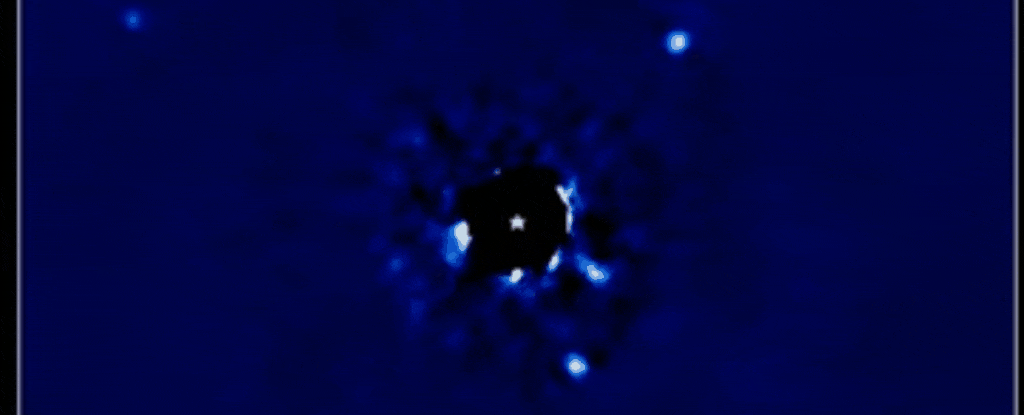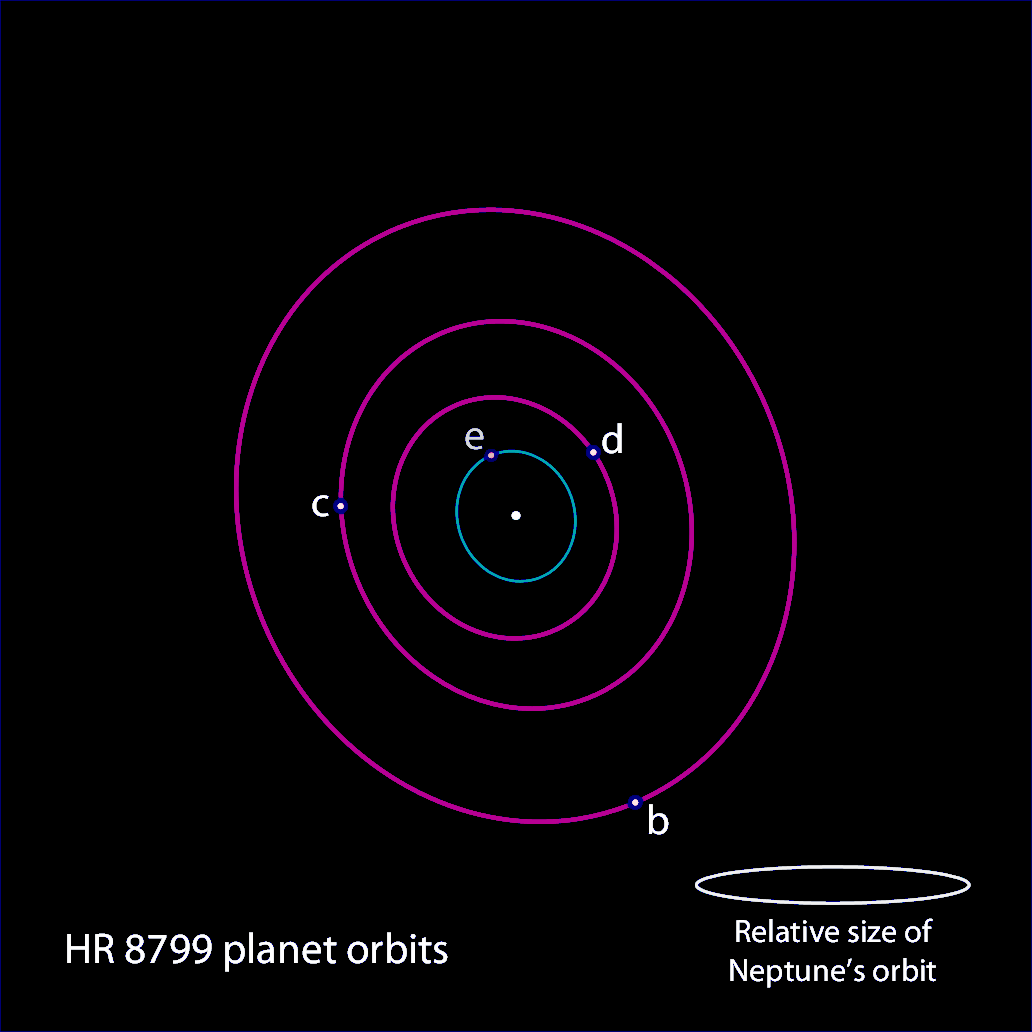It looks like you're using an Ad Blocker.
Please white-list or disable AboveTopSecret.com in your ad-blocking tool.
Thank you.
Some features of ATS will be disabled while you continue to use an ad-blocker.
share:

The video is time-lapse of 12 years of observations of the star is HR8799 and it's planets created by Northwestern University astronomer Jason Wang , Jason used the Keck Observatory in Hawaii.
"There's nothing to be gained scientifically from watching the orbiting systems in a time lapse video, but it helps others appreciate what we're studying," Wang says.
"It can be difficult to explain the nuances of science with words. But showing science in action helps others understand its importance."
The innermost exoplanet is HR8799e, with a mass of 7.4 Jupiters orbiting at a distance of 16.25 times the separation between Earth and the Sun, or astronomical units, for an orbital period of 45 years. Scientists have been able to analyze the light from this exoplanet to determine that it's a storm-wracked baby gas giant.
Moving outwards, HR8799d has the mass of 9.1 Jupiters, and orbits at 26.67 astronomical units for an orbital period of 100 years.
HR8799c is 7.8 Jupiters in mass, orbiting at a distance of 41.4 astronomical units (just a little wider than the separation between the Sun and Pluto) for an orbital period of 190 years. It has water in its atmosphere, scientists have found.
Finally, HR8799b clocks in at 5.7 Jupiters, with a separation of 71.6 astronomical units and an orbital period of 460 years.
www.sciencealert.com...
"There be Aliens"
weird it's the third one that has water, just like earth. Doesn't that make the likely star much larger than our sun or is it unrelated
Does no one question this stuff anymore?
As shown in the timelapse, That first "planet" is about one solar radius away from its supposed sun.... it would be incinerated. It would be the equivalent of mercury being 100x closer to our sun.
Look for yourself. Measure the radius of the sun in the timelapse, and then you'll see that the supposed planet is only about 1 radius away from the sun's surface. No way.
As shown in the timelapse, That first "planet" is about one solar radius away from its supposed sun.... it would be incinerated. It would be the equivalent of mercury being 100x closer to our sun.
Look for yourself. Measure the radius of the sun in the timelapse, and then you'll see that the supposed planet is only about 1 radius away from the sun's surface. No way.
edit on 31-1-2023 by cooperton because: (no reason given)
originally posted by: gortex
a reply to: cooperton
Perspective.
They said themselves it's like a top-down view. Were supposedly viewing this solar system perpendicularly to its solar plane.
You're seeing in that timelapse what should approximately be the furthest distance the planet will be... you can tell because the timelapse shows that's approximately a circular trajectory that the light is taking.
I tried to look for more info, such as how they came up with the numbers but couldn't find anything. It's the classic "I made it up" argument. Trust me, I don't like ruining Santa Claus but unless there's some sort of explanation for its proximity to its sun then this is obviously not a planet. I would be open to changing my mind if there's some better reasoning behind their assumption.
edit on 31-1-2023 by cooperton because: (no reason
given)
edit on 31-1-2023 by cooperton because: (no reason given)
I think it's a stretch to assume the black occlusion disk = the solar diameter. It's actually blocking a much larger area than the solar diameter of
HR8799.
edit on CST31pm2023-01-31T17:35:49-06:00k by tjack because: (no reason given)
a reply to: tjack
I believe your interpretation of the image is much more correct than cooperton's interpretation.
The closest planet to the HR8799 star has a major orbital axis of at least 16 times the distance from the Earth to the sun (16.25 AU), so by earth standards it's not close to the star at all. The star is about 1.5 solar masses so significantly more massive than our sun, but not a super-massive star.
I have to guess you are somehow misinterpreting the size of the star when you look at the image in the OP.
I believe your interpretation of the image is much more correct than cooperton's interpretation.
All four planets b,c,d and e have roughly though not perfectly circular orbits.
originally posted by: cooperton
originally posted by: gortex
a reply to: cooperton
Perspective.
They said themselves it's like a top-down view. Were supposedly viewing this solar system perpendicularly to its solar plane.
You're seeing in that timelapse what should approximately be the furthest distance the planet will be... you can tell because the timelapse shows that's approximately a circular trajectory that the light is taking.
I tried to look for more info, such as how they came up with the numbers but couldn't find anything. It's the classic "I made it up" argument. Trust me, I don't like ruining Santa Claus but unless there's some sort of explanation for its proximity to its sun then this is obviously not a planet. I would be open to changing my mind if there's some better reasoning behind their assumption.
The closest planet to the HR8799 star has a major orbital axis of at least 16 times the distance from the Earth to the sun (16.25 AU), so by earth standards it's not close to the star at all. The star is about 1.5 solar masses so significantly more massive than our sun, but not a super-massive star.
I have to guess you are somehow misinterpreting the size of the star when you look at the image in the OP.
originally posted by: Arbitrageur
The closest planet to the HR8799 star has a major orbital axis of at least 16 times the distance from the Earth to the sun (16.25 AU), so by earth standards it's not close to the star at all. The star is about 1.5 solar masses so significantly more massive than our sun, but not a super-massive star.
I have to guess you are somehow misinterpreting the size of the star when you look at the image in the OP.
That's what the researchers say, but with no good reason to support it besides that they want it to match their theory so they can make the news. In the tinelapse they are blocking the entirety of the sun to observe nearby anomalies. The same thing they do when observing anomalies just around our sun... they block the sun to show the details around the sun.
Why would they have to block such a larger portion in the timelapse unless that was actually the size of that solar systems sun? I'm not blindly trusting the experts anymore. They have to have an explanation, which they don't give. Probably why it's not a peer-reviewed study and instead just a sci-blog craze
I know you guys really want this to be true, but trust your own eyes and look at the proportions...
edit on 2-2-2023 by cooperton because: (no
reason given)
a reply to: cooperton
Why would they have to block more than just the solar diameter? Simple. When you're trying to see the visible light reflected off planets over 130 light years away, you have to have the sensitivity cranked so high that you not only need to block the sun, but the corona, and as much space between the sun and the planets as possible, or the instrumentation would be overwhelmed with the extra light.
When they block our suns solar disk, its to have a clear look at the corona and other relatively nearby objects. Different situation.
Why would they have to block more than just the solar diameter? Simple. When you're trying to see the visible light reflected off planets over 130 light years away, you have to have the sensitivity cranked so high that you not only need to block the sun, but the corona, and as much space between the sun and the planets as possible, or the instrumentation would be overwhelmed with the extra light.
When they block our suns solar disk, its to have a clear look at the corona and other relatively nearby objects. Different situation.
originally posted by: tjack
a reply to: cooperton
Why would they have to block more than just the solar diameter? Simple. When you're trying to see the visible light reflected off planets over 130 light years away, you have to have the sensitivity cranked so high that you not only need to block the sun, but the corona, and as much space between the sun and the planets as possible, or the instrumentation would be overwhelmed with the extra light.
When they block our suns solar disk, its to have a clear look at the corona and other relatively nearby objects. Different situation.
The sun doesn't light up the night sky, so why would a distant star's indirect light interfere with light detecting instruments here on earth? That black disk in the timelapse is blocking all the direct light coming from the star... which makes that the diameter of the star itself.
You have a lot of questions but you don't seem interested in looking for answers.
originally posted by: cooperton
Why would they have to block such a larger portion in the timelapse unless that was actually the size of that solar systems sun? I'm not blindly trusting the experts anymore. They have to have an explanation, which they don't give...
In a word, Glare is the reason they end up blocking a larger area than just the point source of light that is a distant star. Here's an example on the wikipedia glare page, where you can ask a similar question, why can't you just put a little piece of cardboard hanging from a wire a short distance from your camera which is just large enough to cover the flash?

The obvious answer is that wouldn't work because of the glare. So you end up blocking a larger area than just the size of the flash unit, to be able to see better what's near the flash. Glare from stars is similar, since it takes up more width in the image than just the point source of light. Of course the technology for observing planetary systems using a coronagraph is a lot more complex than just using a cardboard disc to block the star's light but in principle you should be able to see the analogy in the above photo that the glare can be much larger than the actual object which is the source of the glare.
originally posted by: cooperton
originally posted by: tjack
a reply to: cooperton
Why would they have to block more than just the solar diameter? Simple. When you're trying to see the visible light reflected off planets over 130 light years away, you have to have the sensitivity cranked so high that you not only need to block the sun, but the corona, and as much space between the sun and the planets as possible, or the instrumentation would be overwhelmed with the extra light.
When they block our suns solar disk, its to have a clear look at the corona and other relatively nearby objects. Different situation.
The sun doesn't light up the night sky, so why would a distant star's indirect light interfere with light detecting instruments here on earth? That black disk in the timelapse is blocking all the direct light coming from the star... which makes that the diameter of the star itself.
Have a read: en.wikipedia.org...
Even solar coronographs cover more than the Sun's diameter. www.youtube.com...
originally posted by: wildespace
Have a read: en.wikipedia.org...
Even solar coronographs cover more than the Sun's diameter. www.youtube.com...
Coronagraphs for our sun are about 10% larger than the diameter or so to prevent glare as arbitrageur was saying, But not 80,000% larger as is suggested in the timelapse.
You can check my math. The star in the timelapse is approximately the size of our sun. The first planet is supposedly 16x further than earth from its sun. Earth is 100x further away from our sun than our sun's diameter...
So Given that the "glare" in the timeapse is about half the distance to the first planet, as shown by the black disc, that means the "glare" is approximately 16 x 100/2 = 800 times larger than the diameter of the sun that is supposedly emitting this effect in the timelapse.
There's no way the glare is 800x larger than the star/sun itself. To re-emphasize, The coronagraph shadow for our sun need only be about 0.1x larger than the sun itself. Point me to the optical miracle that allows this astronomically large discrepancy in space.
edit on 3-2-2023 by cooperton
because: (no reason given)
a reply to: cooperton
Here's a diagram showing the orbits of the 4 planets around HR 8799.

Here's a diagram showing the orbits of the 4 planets around HR 8799.

The outer planet orbits inside a dusty disk like the Solar Kuiper belt. It is one of the most massive disks known around any star within 300 light years of Earth, and there is room in the inner system for terrestrial planets.[22] There is an additional debris disk just inside the orbit of the innermost planet.[8]
The orbital radii of planets e, d, c, and b are 2–3 times those of Jupiter, Saturn, Uranus, and Neptune's orbits, respectively. Because of the inverse square law relating radiation intensity to distance from the source, comparable radiation intensities are present at distances √4.9 ≈ 2.2 times farther from HR 8799 than from the Sun, the upshot being that corresponding planets in the solar and HR 8799 systems receive similar amounts of stellar radiation.[8]
en.wikipedia.org...
originally posted by: gortex
The outer planet orbits inside a dusty disk like the Solar Kuiper belt. It is one of the most massive disks known around any star within 300 light years of Earth, and there is room in the inner system for terrestrial planets.[22] There is an additional debris disk just inside the orbit of the innermost planet.[8]
The orbital radii of planets e, d, c, and b are 2–3 times those of Jupiter, Saturn, Uranus, and Neptune's orbits, respectively. Because of the inverse square law relating radiation intensity to distance from the source, comparable radiation intensities are present at distances √4.9 ≈ 2.2 times farther from HR 8799 than from the Sun, the upshot being that corresponding planets in the solar and HR 8799 systems receive similar amounts of stellar radiation.[8]
en.wikipedia.org...
If you go to the citations on the wiki page, you will see these numbers are just estimations. We suppose scientists have a magic measuring wand but the reality is they don't know. Given our contemporary models are vastly inaccurate for describing motions outside our solar system, approximately 2,000% wrong, I really can't take any of these estimates seriously. This is why they theorize the existence of dark matter/energy, they are begging for a non-existent substance to exist so that their equations actually work. They rely on people not questioning them. I'm done trusting the science blindly.
Regardless, the glare is by no means 800x larger than the sun itself. They're simply riding off the hopes of readers who want evidence of exoplanets. Like a preacher telling their congregation what they want to hear, rather than the humbling truth of the matter. At least they didn't have any tacky CGI images of theoretical planets on the page.
edit on 4-2-2023 by cooperton because: (no reason given)
edit on 4-2-2023 by
cooperton because: (no reason given)
new topics
-
A Warning to America: 25 Ways the US is Being Destroyed
New World Order: 3 hours ago -
President BIDEN's FBI Raided Donald Trump's Florida Home for OBAMA-NORTH KOREA Documents.
Political Conspiracies: 9 hours ago -
Maestro Benedetto
Literature: 10 hours ago -
Is AI Better Than the Hollywood Elite?
Movies: 10 hours ago
top topics
-
President BIDEN's FBI Raided Donald Trump's Florida Home for OBAMA-NORTH KOREA Documents.
Political Conspiracies: 9 hours ago, 28 flags -
Gaza Terrorists Attack US Humanitarian Pier During Construction
Middle East Issues: 15 hours ago, 8 flags -
Massachusetts Drag Queen Leads Young Kids in Free Palestine Chant
Social Issues and Civil Unrest: 17 hours ago, 7 flags -
Las Vegas UFO Spotting Teen Traumatized by Demon Creature in Backyard
Aliens and UFOs: 14 hours ago, 6 flags -
A Warning to America: 25 Ways the US is Being Destroyed
New World Order: 3 hours ago, 6 flags -
Meadows, Giuliani Among 11 Indicted in Arizona in Latest 2020 Election Subversion Case
Mainstream News: 17 hours ago, 5 flags -
2024 Pigeon Forge Rod Run - On the Strip (Video made for you)
Automotive Discussion: 15 hours ago, 4 flags -
Is AI Better Than the Hollywood Elite?
Movies: 10 hours ago, 3 flags -
The functionality of boldening and italics is clunky and no post char limit warning?
ATS Freshman's Forum: 16 hours ago, 1 flags -
Maestro Benedetto
Literature: 10 hours ago, 1 flags
active topics
-
Gaza Terrorists Attack US Humanitarian Pier During Construction
Middle East Issues • 34 • : AllisVibration -
Victoria government has cancelled the commmonwealth games, no money.
Regional Politics • 3 • : nazaretalazareta -
A Warning to America: 25 Ways the US is Being Destroyed
New World Order • 2 • : Disgusted123 -
President BIDEN's FBI Raided Donald Trump's Florida Home for OBAMA-NORTH KOREA Documents.
Political Conspiracies • 19 • : ADVISOR -
When an Angel gets his or her wings
Religion, Faith, And Theology • 22 • : AcrobaticDreams1 -
King Charles 111 Diagnosed with Cancer
Mainstream News • 321 • : FlyersFan -
Is there a hole at the North Pole?
ATS Skunk Works • 41 • : burritocat -
Massachusetts Drag Queen Leads Young Kids in Free Palestine Chant
Social Issues and Civil Unrest • 16 • : FlyersFan -
Weinstein's conviction overturned
Mainstream News • 24 • : burritocat -
-@TH3WH17ERABB17- -Q- ---TIME TO SHOW THE WORLD--- -Part- --44--
Dissecting Disinformation • 690 • : burritocat

